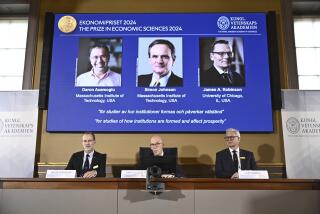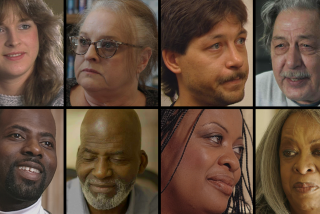Fighting poverty, from one point of view
Within days of the Sept. 11 attacks, World Bank President James Wolfensohn had seized upon the tragedy to argue that fighting poverty was now more important than ever. “There is no wall” separating rich nations from poor, Wolfensohn declared. “We are linked by ... migration, by environmental degradation, by drugs, by financial crisis and by terror.” In short, fighting poverty in poor nations -- the World Bank’s mission -- was in rich nations’ self-interest.
“The World’s Banker” offers an informative but one-sided description of how the institution has approached that fight during Wolfensohn’s two terms as its president, from 1995 to now. Wolfensohn granted 20 hours of interviews for this book, and his gargantuan personality -- “part bon vivant, part missionary, part tyrant” -- dominates from start to finish. Author Sebastian Mallaby, a Washington Post columnist, also seems to have spoken with scores of the bank’s staff and reviewed many official documents.
This enviable journalistic access may account for the twin strengths and weaknesses of the book. On the positive side, “The World’s Banker” provides copious detail on the inside workings of the bank and its president: how the major development strategies of the last 30 years were chosen; how Wolfensohn analyzes poverty; what he did about Third World debt relief; why he saw the bank’s sister institution, the International Monetary Fund, as more foe than friend; and why the bank took so long to awaken to the AIDS epidemic, which is projected to kill more people than World Wars I and II, the Korean and Vietnam wars combined.
Mallaby overstates when he calls the bank the rich world’s “main instrument” for fighting poverty. Reforming the terms of trade for agricultural goods -- the province of the World Trade Organization -- would actually help poor nations most of all. But the bank does lend poor nations $20 billion a year, and its practical leverage over them is greater still. Without the bank’s stamp of approval, they cannot hope to attract much corporate investment, which is where the real money is. As the AIDS crisis illustrates, what the World Bank does or doesn’t do can be a matter of life and death for millions. By burrowing inside the bank and presenting his findings with clarity and wit, Mallaby has produced what amounts to an unofficial history that will be useful to anyone seeking to understand this powerful institution.
Unfortunately, his insider sympathies lead him to shortchange key aspects about the bank. He also misrepresents the views of critics with whom he disagrees and does little firsthand reporting among poor people who have been affected by its policies. He seems to have made only two brief overseas trips, to Chad and Uganda, offering well-told but too brief accounts. “The World’s Banker” ends up covering poverty more through the prism of Washington power struggles than through the eyes of the poor -- strange, given that Mallaby faults the bank for paying more attention to rich nations’ views than to those of poor nations.
Nor are the elite policy disputes fairly portrayed. The bank’s internal critics are given pages and pages to complain about, say, Wolfensohn’s evidently chaotic management style. External critics, by contrast, are disparaged with name-calling, and their more thorough critiques are ignored.
Nobel Prize winner Joseph E. Stiglitz, who served as the bank’s chief economist during part of Wolfensohn’s tenure, is absurdly caricatured as a virtual street protester motivated solely by ego. Economics scholar Susan George is called one of the bank’s leading critics, but Mallaby gives no hint of what she actually thinks; her writings are summarized in a single word: “vociferous.” He dismisses most nongovernmental organizations with ridiculing one-liners -- “parasites,” “rag-tag,” “screamers,” “the Berkeley mafia,” “the Lilliputian menace” -- without fairly engaging the substance of their arguments.
In a typical passage, an activist in the International Rivers Network confesses to having used his supposedly “enormous” leverage to keep developing nation governments out of the deliberations of the World Commission on Dams. In reality, that commission brought together governments, industry and nongovernmental organizations under bank sponsorship and was chaired by the South African government’s water minister. What’s more, the activist’s supposed confession made a different point: not that governments were excluded but that pro-dam governments such as India and China didn’t organize themselves effectively enough to control how the commission was structured and mandated.
In the end, the commission concluded that dams had produced benefits for poor nations but these were outnumbered by their drawbacks, including cost overruns, environmental damage and displacement of indigenous people. Mallaby says nothing about these findings, instead condemning the report as “a virtual ban” on dam building.
It’s fine for authors to have strong opinions, but ideological bias should not trump checkable fact. Mallaby is a talented writer who cares about the plight of the poor. Too bad he doesn’t care more about fairly presenting a problem that, as Wolfensohn rightly insists, matters urgently to rich and poor alike.
Mark Hertsgaard is the author, most recently, of “The Eagle’s Shadow: Why America Fascinates and Infuriates the World” and “Earth Odyssey: Around the World In Search of Our Environmental Future.”
More to Read
Sign up for our Book Club newsletter
Get the latest news, events and more from the Los Angeles Times Book Club, and help us get L.A. reading and talking.
You may occasionally receive promotional content from the Los Angeles Times.








